The Guardsman


The





The Guardsman editorial board calls for your response to a matter that concerns the quality of life for all San Franciscans.
The decisions made on the city budget this year will set an example for the quality of education provided nationwide.
We call on you to protect the nation's first tuition-free community college program—Free City College.
In your address, you stated that your inauguration marked the beginning of a new era of accountability and change at City Hall, that “above all else serves the people of San Francisco.” We just hope that statement remains true.
Last year's budget reneged on a deal made with the Board of Supervisors for the first time, by taking away money allocated for the Free City program.
The budget proposal stated that the program's funding would be reduced to $7.15 million by 2025–26—less than half of what the voters approved. Clearly, this is not even enough to cover the average level of support for students.
The former Mayor's office told Trustee Alan Wong that the situation regarding funding for Free City had changed, and if we didn't like it, we could have a public conversation about it. Consider this the beginning of that public conversation.
The city had a 10-year agreement with City College. Regardless of unspent funds, that money should belong to students. And if the Free City Oversight committee isn't even authorized to use the funds to cover the costs of other enrollment-related roadblocks for students, then can you truly say our money is being left on the table?
City College is in a critical moment. It faces an ongoing budget crisis and a stagnation of state funding levels until it can increase enrollment. Meanwhile, the college has over a thousand students on waitlists who cannot enroll and continue their education because it lacks the funding to hire more faculty.
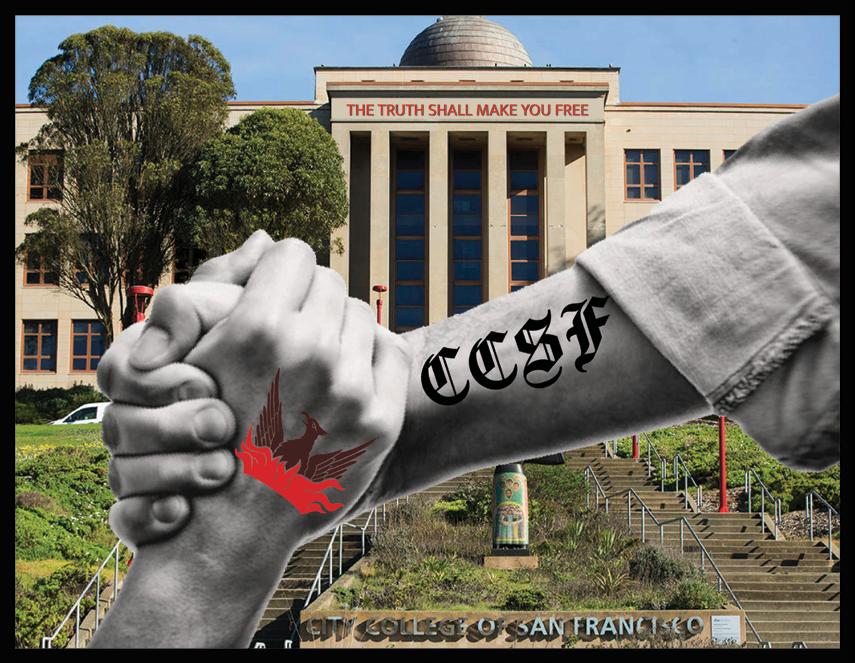
"How many more opportunities for economic and social mobility at City College will be overlooked by the neglect of this public institution?"
City College has its own budget deficit to deal with. So how can you, in good faith, take away from our money to deal with the city's?
No doubt managing the city's $800 million deficit requires difficult decisions, but to base funding for the college on outdated enrollment numbers and the recent spell of unstable leadership, when the Ocean campus facilities and Ingleside community are in the early stages of a renaissance, is at best a short-sighted band-aid to address the city's more significant issues.
This year is City College's 90th anniversary. A time when our newly constructed state-of-the-art buildings are deserving of your presence and celebration. Now is the opportunity to set an example for our country, of how crime and homelessness can be healed with the support of community resources and workforce training programs.
As mayor, you have the power to rejuvenate public interest in City College. Come stand in front of our buildings. Join in the anniversary celebrations. Call on organizations, corporations and philanthropists to assure that it will always be there when our people need it.
Across the six campus locations, from Bayview to Downtown, students can connect with the most representative cross-sections of San Francisco residents. In our classes are former retired police chiefs, immigrants from all over the world, unhoused people living in vehicles or homeless shelters with dreams of reentering the workforce, young engineers aspiring to be the next generation of NASA employees or tech entrepreneurs, and retired Bay area natives looking to stay active in their community.
If Downtown First Thursdays is a strategy for improving downtown
business through arts and culture, then the city requires a pipeline of homegrown artists and entertainers to keep this culture alive.
In a Guardsman article about the loss of our Aircraft Maintenance Technology program, we showcased how United Airlines was forced to offer relocation bonuses to out-ofstate mechanics who ultimately lived in RVs in employee parking lots before returning “home” with their earnings. How many more opportunities for economic and social mobility at City College will be overlooked by the neglect of this public institution?
This is why the college is the city's most undervalued asset. This institution is already positioned to increase tax receipts and decrease the demand for social services.
According to an EMSI Burning Glass report from 2022, California community colleges have an annual
economic impact of over $120 billion, a considerable portion of California's total gross state product. The report also revealed that community colleges are among the state's largest employers and that, for taxpayers, every dollar directed at supporting community colleges has a 100% rate of return over time.
City College is more than just a community college. It is the bridge to the future for a thriving economic and cultural metropolis. A pathway for thousands of SF residents to evolve and improve their skills and capacity for the challenges ahead. Without them, we could not continue to revitalize neighborhoods and businesses with the extraordinary creative talent that San Francisco personifies.
City College exists to serve the people of San Francisco. Interim Chancellor Bailey said it best, “City College is a mirror for this city.”
Therefore, a willingness to fight for City College shows a willingness to fight for the people of the Bay Area.
Only four years remain in the initial 10-year commitment made by the MOU. At this point, it may be renegotiated relative to the student demands of that moment.
To reduce the scope of this place that so many people call their home, would go against the grain of your nonprofit's mission of fighting poverty and providing solutions for unhoused residents.
And to believe in City College, is to continue to believe that change is possible here in San Francisco. With your public support, City College of San Francisco can continue to serve as a free-access resource hub for residents of all demographics and walks of life.
This is the future we envision. The Guardsman takes our role very seriously in safeguarding this institution. On behalf of City College and all people of San Francisco, we challenge you to honor the will of the voters and fight for our home.
We are all passionate about this city's evolution, and we are all in this together. But how you choose to serve our community is now up to you.
—The Guardsman Staff
Staff
Editor-in-Chief
John R. Adkins
News Editor
Tabari Morris
Feature Editor
Rae Daniels-Henderson
Op-Ed Editor
Emily Thorsen
Sports Editor
Brett Abel
Social Media Editor
Fran Smith
Photo Editor
Kyra Young
Copy Editors
John R. Adkins
Kyra Young
Writers
Cooper Maldonado
Ellen Yoshi
Finbar Labelle
Henry Crowell
Karim Farahat
Qi Mai
Photographers
Bob Kinoshita
Isaac Ortiz
Karim Farahat
Illustrators
David Thomas
Isis Cordova
Graphic Designers
Cindy Chan
Isabelle Salvadori
Sebastien Thugnet
Tiffany Lam
Xiaoyi Yu
Advisor Juan Gonzales jagonzal@ccsf.edu
Contact us
TheGuardsman.com
info@theguardsman.com (415) 239-3446
Mailing Address
50 Frida Kahlo Way, Box V-67 San Francisco, CA 94112 Bungalow 615
Follow us

@TheGuardsmanCCSF

@TheGuardsmanCCSF

@TheGuardsman


By Kyra Young kyrajyoung@gmail.com
Constituents across multiple organizations continue to navigate the fear and confusion of the threats to undocumented students.
On the morning of Tuesday, March 4, Interim Chancellor Mitch Bailey sent out a memo to City DREAM Manager Maria Rodriguez before it was approved for circulation. The memo was a two-page advisory on how to respond if approached by immigration enforcement officials at City College, with a condemnation of the “direct attacks on our undocumented, queer and trans community and female/femme-presenting and identified people.”
It also indicated the Chancellor as the only authorized individual to accept warrants, legal documents and court orders from any immigration officers.
This document comes two weeks after the first meeting of an advisory group around undocumented and LGBTQ+ student protections as advised by a resolution the Board of Trustees passed in January.
“I'm hoping [the advisory group] can grow into having a deeper conversation about ways the institution can really provide support for the various areas of the college,” said Rodriguez. “It's not just one area that needs guidance and support right now, it's all across the college, and this can really centralize that support and get us to think of ways we can collaborate with one another.”
Later on March 4, members of City DREAM and the Immigration Institute of the Bay Area hosted a two-part UndocuAlly training alongside a number of other workshops as part of the college's scheduled professional development day.
The training, “Moving From Allyship Into Action,” was designed to raise awareness of the complex, day-to-day experiences of undocumented students. The second session specifically served as a know-yourrights crash course, facilitated by Veronica Guinto, a senior attorney with the IIBA working with students from City College.
Faculty in attendance were educated on the distinction between public and private spaces and what is meant by a “sanctuary” status, as well as how to protect themselves and their rights during interactions with law enforcement and immigration officials.
Steven Mayer, co-coordinator of the Puente program at Mission Campus, believes it's fundamental for faculty to learn their rights, and ensure those rights are known by their students. “They need to understand what to do if ICE comes onto campus, and how to protect their students as best as possible.”
The Puente Project is a national award-winning program that aims to improve the college attendance rate of California's educationally underrepresented students. Mayers works consistently alongside students who could use more support, but don't have access to the traditional support systems other students may be able to utilize.

No matter their documentation status, students can obtain red cards in Spanish, English and Chinese from the City DREAM office to remind them of their rights. March 6, 2025
(Kyra Young/The Guardsman)
“We work very closely with City DREAM, and City DREAM has become a really valuable source of stability in the lives of many of our students with Puente,” said Mayer. “It's important to understand what our immigrant students are facing and listen to their stories. Most faculty I know at City College really get to know their students and establish good relationships with them.”
Mayer was one of several faculty members who attended the UndocuAlly training, where numerous questions were raised regarding City College's sanctuary status.
Both the city of San Francisco and City College have adopted sanctuary ordinances—the city passed its “City and County of Refuge” ordinance in 1989, and the college adopted its own in September of 2017. However many are left to question what the “sanctuary” label can and cannot do for its residents.
“There is a misconception about the scope of what it means to attend a sanctuary campus or what living in
a sanctuary city means,” explained Veronica Guinto, a senior attorney with the Immigration Institute of the Bay Area working with students from City College. “The term ‘sanctuary’ refers to the fact that the school or municipality has enacted laws or policies such that it will not use the city or school's resources to assist or aid in federal immigration enforcement, unless required to do so by law, such as a judicial warrant.”
Because City College is a public institution with an open campus, the sanctuary status cannot protect undocumented students from ICE officials coming onto campus. Public spaces on a campus could be front offices or lobbies, bathrooms, hallways, or open green spaces such as a campus quad. However, spaces like classrooms and offices are considered private spaces that would require a proper warrant to enter.
“Your classroom is considered a private space in the way that not just anyone from the general public could be present while you're teaching,” explained Guinto. “If you have the restriction that someone has to be a
registered student, or have a student ID, or some sort of permission from somebody to audit the class, it means the area for your general classroom would be considered a private space.”
Guinto also emphasized the importance of verbally asserting one's rights in an incident where intimidation or force may be used against them, such as maintaining the protections of a private space.
The training addressed a number of other concerns raised by faculty, such as how to visibly demonstrate allyship, private versus public areas, what a judicial warrant looks like and whether officers could be armed.
“Ideally, it would be nice if there was more interest in the education of how to respond to law enforcement—or if they're on campus, how faculty can protect their students,” said Guinto, reflecting on the workshop.
“Staff having the education is great, but more visibility is also important,” Guinto continued. “That visual communication of allyship, like a pride flag or a butterfly, maybe those should be in every classroom or every hallway. It communicates who we're allies with.”
Another know-your-rights training in collaboration with City College Labor Studies, The IIBA, City DREAM and the San Francisco Labor Council will be hosted at City College's Mission Center on Saturday, March 15 from 10 a.m.–4p.m. This event is open to the public.
Editor's note: The Guardsman would like to remind the community that if approached by ICE, it is helpful to state that you will not speak without the advice of your attorney.
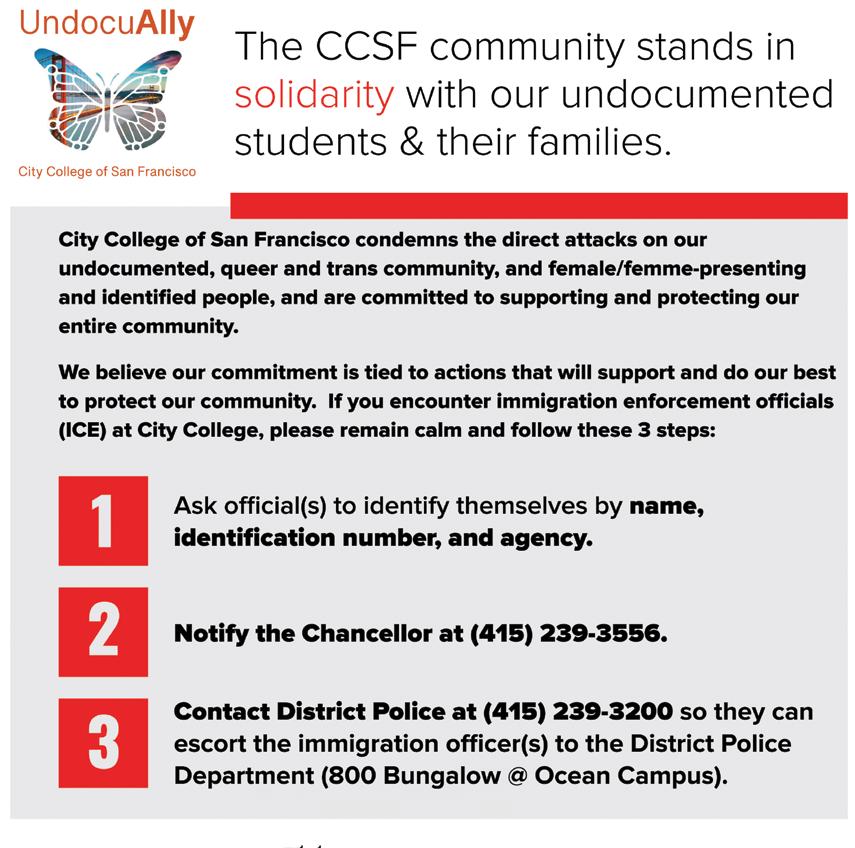
By John R. Adkins jradproduction@gmail.com
For over 200 days, Interim Chancellor Mitch Bailey was nothing but transparent about both the state of the college, and his prospect of unemployment. Throughout the fall semester, many found him both honest and approachable, so they were disappointed to hear how adamant he was about leaving after his interim stint.
Both in conversations and in meetings he consistently reiterated, “I'm only going to be here for one year.”
That was until late February when word began to spread that Bailey had thrown his hat into the ring, and applied for the permanent position. On March 1, City College announced the five finalists, confirming that Bailey had indeed been added to the pool.
AGB Search, the hiring firm brought on by the college, began seeking out new candidates as early as September of last year. City College Human Resources confirmed that three applicants were accepted for review after the January 13, “full consideration date.”
“The applications received after the full consideration date were screened on an expedited basis,” stated the HR department.
Now as the screening committee moves onto the final stage of interviewing its candidates during the week of March 10–14, many constituents are left to wonder, “Why did Bailey change his mind?”
“I believe that everyone has the right to change their mind. And I think that he recognizes that he works well with us and wants to see the investment he's already made in the college through,” said Classified Senate President Michael Snider.
When asked what might have caused his change of heart, Bailey responded with one word: “perspective.”
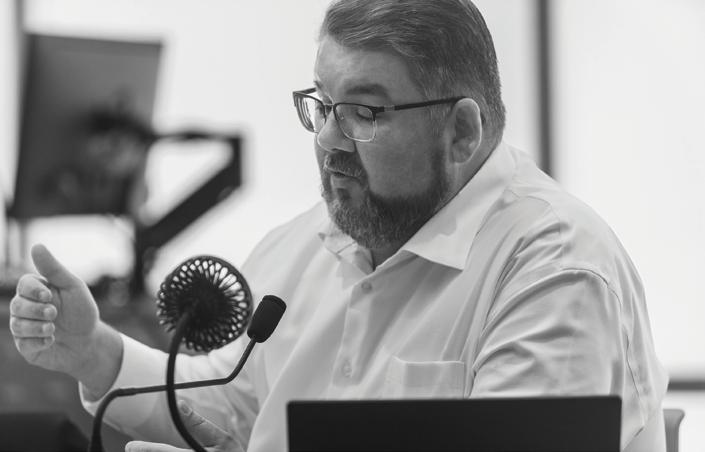
Having taken pride in the progress made on the college's issues, Bailey expressed an interest in helping the college continue to move things forward.
“Getting to work with all those great people, you don't get to see that if you're not inside your organization,” Bailey said.
Bailey is joined on the list of finalists by Henry Yong, chancellor of Yosemite Community College District; Carlos Cortez, a former Chancellor of the San Diego Community College District; Kimberlee Messina, President of Spokane Falls Community College; and Rudy Besikof, President of Laney College in Oakland.
By Qi Mai qmai10@mail.ccsf.edu
City College hopes to continue to mindfully incorporate rapidly developing AI technologies as tools for education.
On March 4, during the college's annual Flex Day, more than 200 City College faculty members actively discussed AI's transformative impact on education and the workforce.
Interim Chancellor Mitch Bailey delivered a pivotal address in MUB 140. There, he officially announced that City College is entering a new era, embracing AI in both the workplace and the classroom.
The Chancellor then gave the stage to keynote speaker Chesa Caparas, who opened the day's itinerary with her introductory discussion “What Are We Talking About When We Talk About AI Today?”
Caparas, who teaches English and Ethnic Studies at De Anza College, focuses her work on supporting the academic and cultural success of Asian American and Pacific Islander students. She also leads professional development workshops on AI in education.
The discussion served a brief history of AI, tracing its evolution from the 1950s to the present. Drawing on her Fulbright research—which focused on teaching media and information literacy during national elections—Caparas then highlighted the many far-reaching impacts AI has had, from one's daily life to democracy and education.
The discussion set the stage for Caparas' subsequent workshop “Beyond the Hype: Balancing the Promise and the Problem of Generative AI in Education,” wherein she addressed college students’ use of AI.
“Curiosity, empathy and compassion” are Caparas' attitudes for students using AI for their academic work. Caparas emphasizes AI should be used as a tool to enhance, not replace.
During a warm-up discussion, in-person and online attendees engaged in candid dialogue about AI's fast, effective capabilities and risks. Faculty members expressed concerns about AI's potential to facilitate academic dishonesty, such as cheating on quizzes, essays and homework.
Stephanie Williamson, a faculty member, voiced a broader fear: AI's role in displacing jobs. Despite these concerns, Professor Caparas' deep AI knowledge and smooth delivery earned her applause and positive feedback.
Community members later reflected on the workshop with a mix of excitement and apprehension regarding AI.

“While AI has useful applications, it's often commercially misrepresented. Many AI queries could be simple Google searches, yet AI consumes vast amounts of water and energy, often with less accuracy,” said Sarah, a student from the Photography Department.
Sarah also raised ethical and legal questions, pointing out that AI models collect data without creators' consent.
“The AI models have scoured the internet for data to build on, without consent of the owners and creators of that data,” said Sarah. “Most current models are also a ‘black box,’ meaning even their creators don't fully understand how they work. This leaves it open to malicious exploitation or accidental harm, with many models lacking built-in safeguards to prevent such issues.”
Rosenburg Library Technician Toni Kibby-Blackburn believes her work provides essential physical services, such as retrieving books, operating computers, handing out laptops, and other tasks that AI cannot easily replicate. She also views AI as having increasingly negative impacts.
Kibby-Blackburn shared a personal story about her daughter, who created an original piece of artwork and posted it online. Later, her daughter discovered that the image had been printed on a T-shirt without her consent, after being informed by a community artist. Feeling that her work had been stolen, KibbyBlackburn's daughter decided to change her major from art to the medical field.
Photography Department Peer Mentor
Travis Chambers shares similar concerns. He believes AI's influence leans more toward the negative than the positive, emphasizing that AI has been used excessively for commercial exploitation. Branding designer Scott Sidorsky acknowledges that AI was developed with commercial interests in mind, but he also recognizes its powerful and effective capabilities in his work.
Back in the day, on campus, our parents' generation carried big heavy backpacks, shuttling from class to class like little ants moving breadcrumbs, pursuing their American Dream. Today, we simply carry nothing more than a small laptop under our arm, like Harry Potter's magic wand, harnessing the power of technology. Every innovation has its pros and cons—and AI is no exception. What City College can do is maximize its strengths and work to minimize its drawbacks.
Some professors, like English professor Alisa Messer, have already begun to implement their own course policies:
“I expect your thinking. Unacknowledged use of AI-based generative tools and LLMs is not okay for this class. CCSF's updated student conduct policy on Academic Dishonesty prohibits the use of generative tools (including but not limited to GPT-4, ChatGPT, Claude, Cohere), without the permission of the instructor to produce responses to school tasks or activities. A student may not use generative tools to produce content that the student submits as the student's own thoughts and/or language.” Messer's AI policy
clearly establishes the expectations for using generative AI tools like GPT-4, ChatGPT, and others in her English class.
As City College embraces this new era in technology, it's worth looking back at the institution's journey through AI discussions:
From 2022 to 2024, City College libraries have taken up the conversation about AI.
In 2024, Dr. Kevin Sherman, the Acting Chair of Educational Technology, joined a statewide collaborative for AI teaching and learning and participated in training programs.
On November 21, 2024, Cynthia Dewar, Chair of the Technology Committee, discussed AI's role in education during a Participatory Governance Council meeting. She highlighted the Technology Committee's goal of creating guidance for using AI in the classroom.
Dewar stressed the need to ensure that AI software supports educational quality, while addressing faculty concerns about AI-generated content, and uphold privacy and intellectual property standards. She also pointed out innovative AI uses in libraries and classrooms, including the implementation of such technology with both Canvas and Khan Academy.
Embracing and celebrating this groundbreaking step into the AI era also calls for remembering and recognizing the dedication and forward-thinking of these AI pioneers at City College.
Looking ahead, City College will continue exploring Artificial Intelligence with a Faculty AI Community of Practice and events on March 28 and May 2.

By Qi Mai qmai10@mail.ccsf.edu
On Feb. 25, more than 30 City College students gathered in MUB 140 for a meditative retreat led by local healers and cultural workers.
The event was sponsored by the Office of Student Equity and produced by QILIG. Kim Acebo Arteche and the Pinay musical duo Astrologik, who make up the QILIG group, aim to facilitate expansive queer experiences that center joy, connection and tend to culture.
The “Community Altar Building and Breathing” event incorporated a breathwork session, led by Arteche. Breathwork involves intentional and conscious breathing techniques designed to expand and improve physical, emotional and spiritual well-being.
While many are familiar with yoga breathwork practices that incorporate meditation mantras and music, the event took a unique approach by integrating Astrologik's sound bath meditation experience.
The sound bath features an array of instruments, including a rain stick, gong, crystal sound bowls, brass Tibetan bowls, hand pan, wind wand, native drum, shaker, water drum, tuning forks, chimes, tingsha bells and goat toes.
The practice began with the high gong's resonant echoing sound. Participants were transported to what felt like a silent temple in the mountains, momentarily escaping the noise of the world. Higher-pitched instruments then followed, creating elegant and distant sounds that seemed to dissolve the participants' consciousness bit by bit.
As their awareness softened, the subtle sounds of the rain stick, like finely crushed sand sifting through fingers, floated into their ears. Gradually, their minds entered a meditative state and their bodies fully immersed into the experience. After only 10 minutes, the participants lost track of time, and didn't realize how deeply they had drifted into relaxation until they awoke feeling balanced, connected and energized.
“It was my first time experiencing a sound fragrance bath and community breathing session,” said Kat S, a student worker from the Queer Resource Center. “I am grateful to the healers and breath workers who came to transmute with us. I think we need more events like these together—we are human together.”
Kimberly Boral, a classified staff member and Work-Based Learning Coordinator, shared a similar excitement. “As a new staff member at CCSF, it was nourishing to breathe and be in community with students, colleagues, and friends.”
Several psychology students echoed these sentiments and expressed appreciation for the opportunity to step away from their academic routines, practice breathing exercises, and embrace a novel, calming experience.
“Students on academic paths often spend much of their time in their minds, which is necessary for study,” said Charito Soriano, one of the two musicians that make up Astrologik. “A sound bath reminds people of the body-mind connection. The
mind's journey is smoother when the body is in sync. It also provides a moment to breathe and pause, which is especially crucial in today's fast-paced world.”
Jing Shi, a student worker at the Math Lab and Student Health Services Group, spoke about how the event came to be. “In December 2024, my team and I participated in a breathwork session at the San Francisco Main Library. We experienced its positive effects and realized how valuable it could be for our students. We pitched the idea to the Office of Student Equity, and with the support of Dean Dr. Tessa Henderson-Brown, we were able to bring this event to life.”
Shi believes combining breathwork with a sound bath is a powerful way to support mental health. “I was really moved by the inclusive space the facilitators created, which is so important as we confront the suppression and oppression faced by vulnerable members of our community,” Shi said.
The Breathwork practice was the first event session in City College's Mental Health Awareness Series for the Spring Semester, arranged by the Office of Student Equity. Upcoming events in the series are as follows.
March 25, 1:30–3 p.m., Patterns That Remain: Unlearning Cultural Scripts about Mental Health in Asian Communities, MUB 140.
April 29, 1:30–3 p.m., Bridge Generations and Identity through Talanoaga: Breaking the Stigma by All My USO'S, MUB 140.
May 13, 1:30–3 p.m., Self-care: Graceful Shirt Designs with Scarves, Batmale Hall 208.

This Women's History Month, The Guardsman talked with some of the passionate individuals who founded the first Islamic Society Club at City College.
The club's first-ever meeting on Thursday, March 6, was a great success. Tea and traditional Palestinian bread was available while club members chatted over the Hijab and other important aspects of the Islamic faith. Members welcome anyone who is interested in learning more about Islam.
The women featured here are all highly intelligent and dynamic individuals that have proven both their care and commitment to City College and their surrounding communities.
Fayza Nasher grew up in Ibb, Yemen, and came to the States in 2012 in search of a better life.
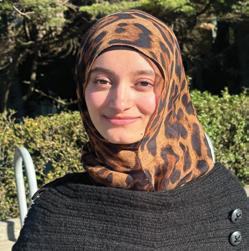
“When I came here there was not a lot of people I knew, and it was very hard, especially last semester… I was eager for this club to happen. It helps with propaganda surrounding Islam, to inform people that all you see in the news is not always the case with people of the Islamic faith… What you see in the news, it's so different from what I see and what I know from my own life, that's why I call it propaganda.”
“One of the things I love about San Francisco is that it is more liberal, and it is so diverse that you don't actually see a lot of those prejudices that are happening in other parts of the world.”
“For me, one of the things I'm most passionate about is my desire for everyone to be treated with equal opportunities, and I want everyone to have a chance to succeed in life, with education and with work.”
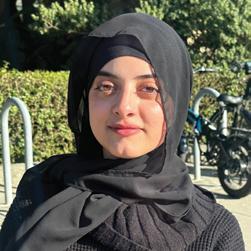
Maha Nasher grew up in Ibb, Yemen, and came to the States in 2010 in search of a better life.
“First of all, you always need a sense of community in life. You need your people, you need some kind of solidarity, and to know that you're not alone, was by itself enough of a reason for us to create this organization.”
“I want everyone around the world, no matter who you are or where you're from, we just want everyone to have peace, that is both my goal and a goal that is shared by everyone here involved in the Islamic Society of City College.”
Fatma Elfadel was born and raised in Saudi Arabia, but came to City College as an international student in 2023 from Khartoum, Sudan.
“I love that you have so much diversity here at City College, people from all different backgrounds are able to come together, and I love that.”
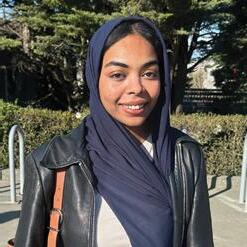
“What I'm most passionate about are human beings. I spend a lot of time just thinking about the diversity of human beings and wanting to engage in conversations with different human beings, and then discovering that we have so much more in common than our perceived differences. But have so many more things I'm passionate about in life, music, food—too many to list.”
On Wednesday, Feb. 26, hundreds of students amassed in the Ram Plaza on Ocean Campus for the spring semester's Unity Day.
The sun broke through for an uncharacteristically warm February day as the music and voices of the various clubs and communities brought the Ocean campus atmosphere to life.
From 10 a.m. to 2 p.m., students enjoyed free tacos and ice cream while connecting with various clubs and resource centers.
The event—organized by the Inter Club Council and ICC VicePresident Vaughn Ledrew—was considered by many to be a great success thanks to the massive turnout and constant streams of boisterous hubbub that resounded across the Plaza that day.
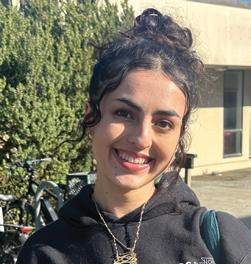
Nura Fattah was born and raised in San Francisco. Her father is from Brazil and her mother is from Saffa, Palestine. Fattah works in the Metro Transfer program and EOPS.
“This college has a lot of opportunities here to make sure you succeed. Oppurtunities that you wouldn't even have at some universities.”
“Obviously after 9/11, there was fear around Islam and Arab people, and while I think it's gotten better since then, it is not a linear thing. For example after the October 7 attacks in Israel, that Islamaphobia I think has risen up again. It's hard to speak out about those things now because you might be called anti-Semitic or Hamas. However I feel that in spite of that, there is a lot of solidarity with those communities, so it's important to be able to debunk the propaganda that is in the West.”
“One day, I really hope to be able to go back to Palestine to be able to help the people there that are oppressed.”
By Karim Farahat
During the last general election, San Franciscans voted in favor of Proposition K, an ordinance that would permanently close the Great Highway to traffic. This proposition has been extremely controversial and has faced resistance from Sunset residents. The last day that the Highway was open to traffic was March 13, with the park set to officially open on April 12.
Prior to the closure, the Great Highway was open to traffic on weekdays before closing on Fridays before noon. I find this to be a great compromise. It accommodates traffic during the week when there are more cars, while promoting beach access and recreation on weekends.
The concern among Sunset businesses and residents is that the closure of the Highway will push traffic onto adjacent streets, resulting in increased accidents and noise in the neighborhood. Ramon J. Ruiz, who lives a block away from the beach said, “47th Avenue becomes the Great Highway.” There is also frustration among Great Highway commuters who are now forced onto the already busy Sunset Boulevard or 19th Avenue to cross the Sunset, exacerbating the traffic delays. “It is an iconic drive” and a “Unique piece of road,” said Chip King.
While the project promises to save taxpayer money by reducing costs of sand removal, locals fear that turning the highway into a public space will incur additional maintenance costs over time. The combined factors of no passing cars, people busy at school and work, and many foggy days in the Sunset will result in the area remaining largely unused. The desolate highway could leave Ocean Beach vulnerable to more homeless people seeking refuge in the dunes or an increase in accumulated litter. Federal employees responsible for maintaining the two-and-a-half-mile stretch of beach have insufficient resources to collect litter periodically, so we rely on volunteers' efforts to keep our beach clean. Dagan Ministero, a Sunset local who surfs on Ocean Beach daily and manages Aqua Surf Shop on Judah and 44th Avenue, said, “There's more people on staff but it's only four guys maintaining the two-and-a-half-mile stretch of beach.” With federal budget cuts, there is little optimism around an appropriated larger fund for Ocean Beach maintenance, resulting in a deterioration of the landmark.
Many Mission residents were drawn to the idea of more public space and pointed out that they would occasionally benefit from the closure of the Highway. “I liked biking
up and down the road,” said Ashley Spencer. Resident Jeff Ondocsin agreed, “It's always nice to have more parks.” Hence, many supported the ordinance without recognizing the latent drawbacks for the local community.
According to city data, the Sunset's population is 83,259 of the total 808,437 residents of San Francisco. While the whole city had a say on Proposition K, the consequences of it fall entirely on the west side of the city, which clearly voted against it. “The only people who seem to want it aren't from here,” Ramon J. Ruiz said.”
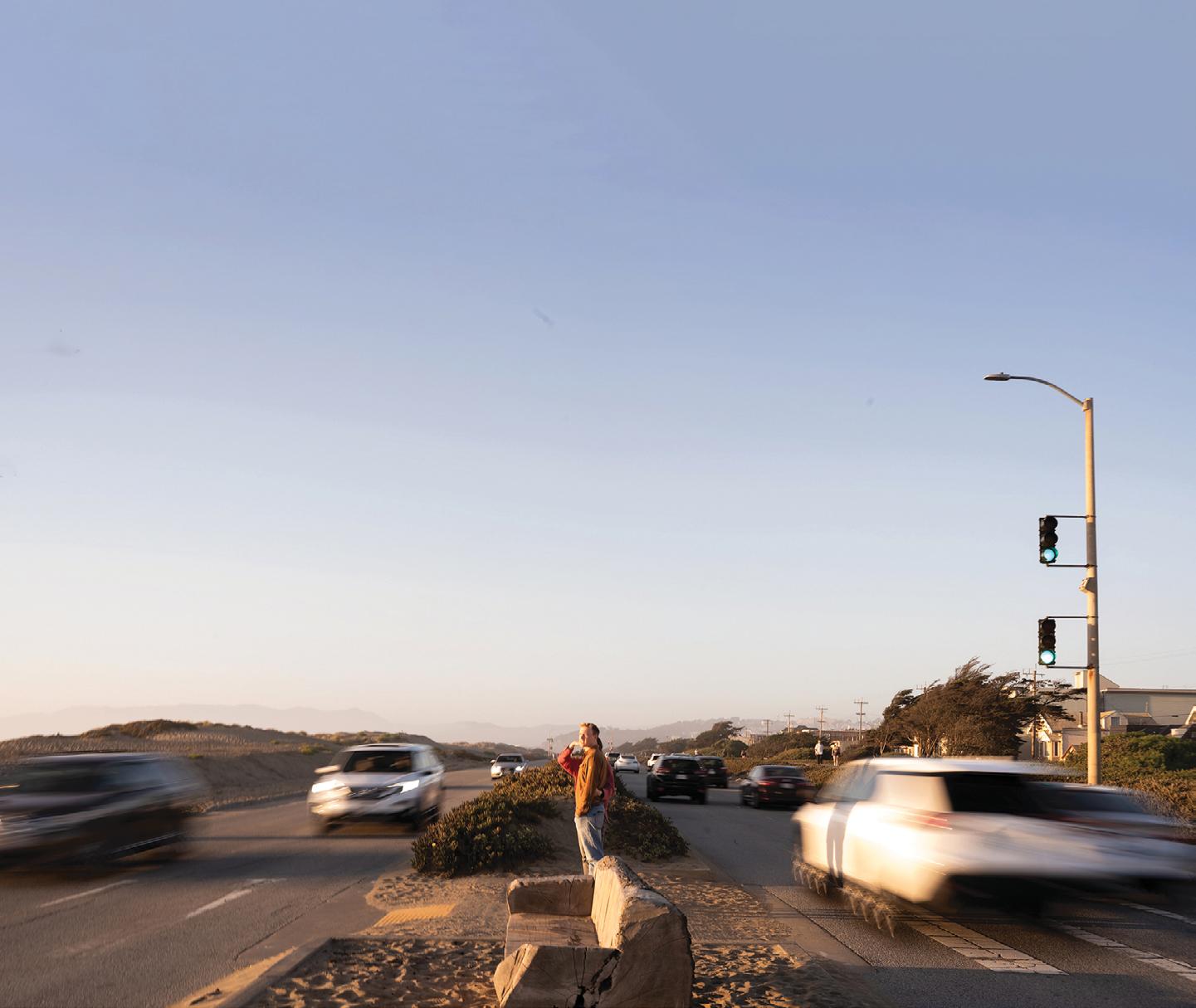
By Finbar LaBelle finbarlabelle@bennington.edu
The first Slow Street Corridor erected in San Francisco was the Sanchez Slow Street, from 23rd Street to 30th Street in Noe Valley. The project, another pandemic convenience, was by the Municipal Transportation Agency until December 2022. Life had slowed down, so why shouldn't the streets? San Francisco suddenly became a slow suburb, at least in its more residential areas. However, the privilege seemed reserved only for the wealthy. Slow Streets introduce undeniable benefits to the community, the environment and family accessibility. They support the city's efforts to create a citywide Active Transportation Network while encouraging residents to use more low-carbon transportation methods in their daily commutes. The SFMTA claims Slow Streets as “safe, comfortable, low-vehicle-traffic routes that prioritize active transportation and community-building, designed to provide safe, comfortable alternatives to driving.”
Substantial cases can be made that Slow Streets combat traffic-related injuries and even deaths. According to an article from KQED published in February of this year, Slow Streets have reduced “injury collisions” by 61% on participating slow streets. However, while acknowledging these positives, one should always be encouraged to question the City's motives regarding regulations and policies, especially those tailored to specific demographics. This examination becomes crucial in a city as socioeconomically stratified as San Francisco. More often than not, serving one community disserves another.
I encourage a healthy amount of critical inquiry as you begin to plot out where Slow Streets are and where they are not. In spring 2020, there were 14 Slow Streets. Currently, there are 18 throughout the city. Neighborhoods with access to Slow Streets include affluent areas such as the Presidio, Noe Valley and Duboce Triangle. There comes a time when we must come to terms with what can be bought in this city. The city can put a price tag on almost anything.
Why must the rich reserve entire streets for recreation? Projects like Slow Lake—funded by those seeking to privatize their own neighborhoods—are often presented as universally beneficial, yet mask a clear undercurrent of classism. The integration of these Slow Streets throughout the city has created an illusion of suburban living in San Francisco. Not everyone has the privilege of seeing the city in this way; some struggling residents are forced to see this seven-by-seven-mile grid for what it is— a diverse and bustling city.
But hey, if you and your neighbors have the sway, go ahead. Take the city. Walk with your $15 coffee and blast those noisecanceling Apple headphones. There is no need to worry that your rare breed of Australian-Tibetan Mastiff may get cut off by a jogger because you can simply walk in the middle of the street.
Have no fear anymore of riding your bike with your iPad XL in hand, and hell, throw on your VR headset while you work on your AI start-up from the comfort of your own corridor of streets. The city is yours. You may have just moved here a month ago, but isn't it so splendid that elites before you have redone city planning so that you will always have your parking spot as well as your garage? Now think, is there a Slow Street in your neighborhood? Or do you happen to be part of a more urban and populated city sector where life can't afford to slow down?
Think of neighborhoods like Bayshore and others, where substantial numbers of families reside, and yet those areas will likely never be afforded the luxury of a Slow Street. Suddenly, the issue raises questions about accessibility. Gated communities like Presidio Terrace could be considered one large and ostentatious slow street. Life moves at a leisurely pace on Easy Street, at least for those who live there. However, this pace does not suit everyone, and seems to install an invisible fence around such spaces.
The more you look around at this beautiful city, the more you realize it has been bought, sold and sanitized. Money has
ushered in a new generation of transplants who have changed the face of San Francisco right down to the street level. And although the city has become their playground, it rarely benefits the people who are actually from here.
Our own government is kicking other crises like homelessness under the rug for the sake of a pristine, picture-perfect neighborhood that borders on a slow New Jersey county. San Francisco seems to be the best of both worlds. Can you afford both sides?
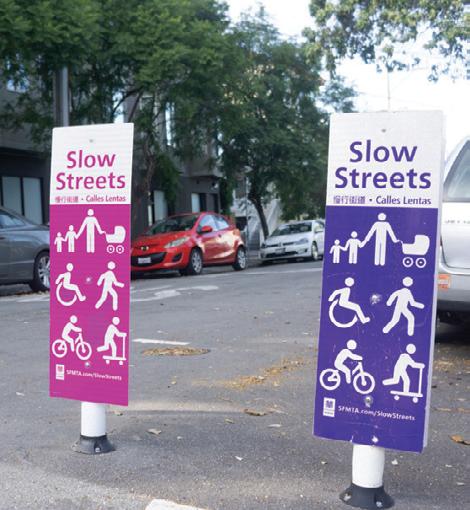
By Emily Thorsen ethorsen@mail.ccsf.edu
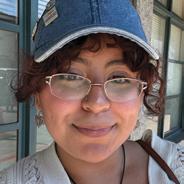
“I urge the Board of Supervisors and Mayor to acknowledge what the cuts to this program could and are doing to our student community. Students are voicing their demands to reinstate our funding and provide autonomy to use the funds. Expand its reach and address as many students' needs to support their journeys to receive free education!”
Mariela Haro, Data Science Major
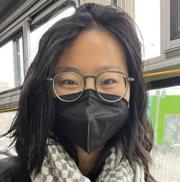
“Mayor Lurie and the supervisors need to take note that access to education should only be expanded, not cut. Although the Free City program is the first in the nation to offer free community college education to its residents, it is in danger of being further cut back. Rather than being the admin to point flaws at CCSF, he and his team need to work with us to reinstate the cut funding and allow City College to use the money freely.”
Jing Shi, Social Justice and Social Work Major
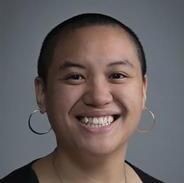
“Free City helps me achieve my career of helping the people of San Francisco without having the financial burden of both tuition and rent. If it wasn't for Free City, I would not have the opportunity to be the first in my family to go to college, like thousands of others benefiting from this program. I dream of helping the city of San Francisco, I hope Mayor Daniel Lurie and the Board of Supervisors will help students like me achieve our dreams.”
Rheanna Montero, Sexual Health Education and Humanities Major

“With his power and privilege, Mayor Lurie has a duty not only to stop further budget cuts but also to use his money to help restore various programs and services. Budget cuts to services that support marginalized communities will hurt our school and our city. The Free City movement is about more than simply providing quality education and resources for lower-income and working people; it is about strengthening and uplifting our entire city.”
Jocelyn Wong, Undecided Major
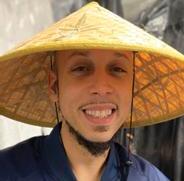
“I would like Mayor Laurie and the Supervisors to know that we, City College of San Francisco students, are the foundation of human capital that this city will stand on. We will be the health-providers, workers and teachers that SF's life will depend on to survive. The best he can do to support CCSF is give all the resources we are telling him we need for our education. Starve our education, and the city will suffer the consequences.”
Eddie Escoto, Biology Major
MON 17
Defend Free City
Teach-In/Town Hall Discussion at the Lower Level of Student Union 1:00 p.m.–2:30 p.m.
TUE 18
Degree Works (In-Person)
Workshop to learn how to track academic progress and plan your educational goals on the Ocean Campus, lunch will be provided. 12:00 p.m.–1:00 p.m. | MUB 361 RSVP Online: https://tinyurl.com/DWInPerso
WED 19
Resume Essentials Workshop Resume dos and don'ts. All parts of a resume and how to construct them. Awesome resume templates. Open to all disciplines. 3:30 p.m.–4:30 p.m.
RSVP Online: https://tinyurl.com/wfwrsvp
WED 19
Defend Free City Teach-In/Town Hall Discussion at the Lower Level of Student Union 5:30 p.m.–7:00 p.m.
WED 19
3rd annual Community Iftar
Join City College with a night of delicious food, unity, and celebration. 6:30 p.m.–8:30 p.m. | STEAM Building https://bit.ly/ccsf25iftar
FRI 21
Degree Works (Virtual) Workshop presented by the Completion Center to learn how to track academic progress and plan your educational goals.
10:00 a.m–11:00 a.m.
RSVP Online: https://tinyurl.com/DWVirtual
TUE 25
aaNhPISaP Mental health Series
Join Dr. Stacey Diane Arañez Litman for Patterns That Remain: Unlearning Cultural Scripts About Mental Health in Asian Communities.
1:30 p.m.–3 p.m. | MUB 140
RSVP Online: bit.ly/AANHPISP25
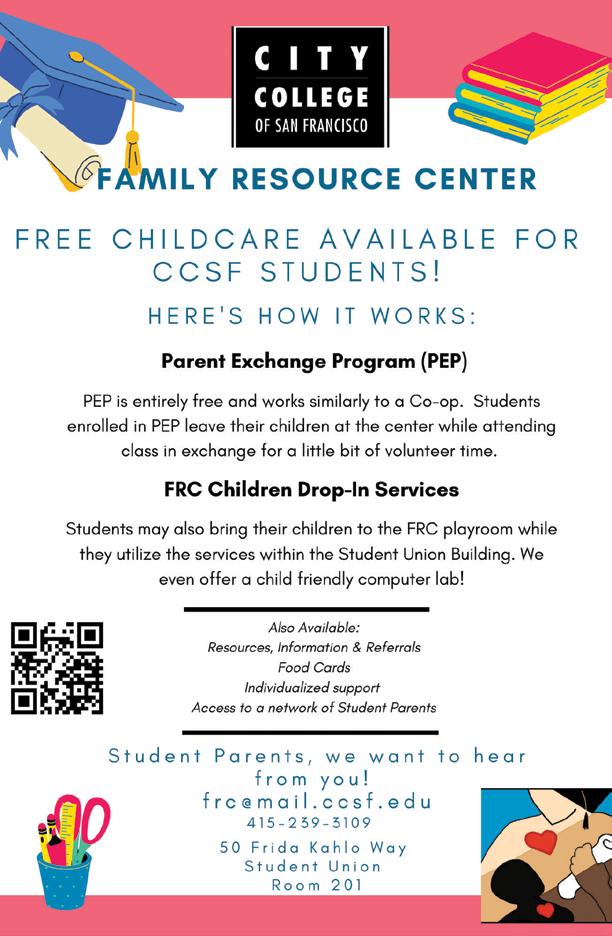
By Dante Torrano dante.torrano@gmail.com
On Saturday night, the City College Rams began their playoff run with a commanding 88–62 victory over Fresno City College. Led by standout guard Miles Amos, the Rams demonstrated excellent command over the game as they locked horns with the Fresno City College Rams.
It was a playbook clinic on efficient offense and stifling defense, with a mandate so overwhelming that their opponent found it challenging to be on the same court, much less in the same league.
It wasn't all easy dribbling for the Rams, as they started off the game with an undeniably slow tempo. The coach struggled to get the team into rhythm, and for much of the first half, the energy on the court felt disjointed. “They came into the game very nonchalant,” said Head Coach Justin Labagh. Whether it was coaching or execution, they weren't feeling it—and neither was the crowd.
As the clock ticked on, the Rams flipped a switch and took control of the game. Leading an attack that would define the rest of the night, point guard Miles Amos disrupted passing lanes, charged through defenders and set a tone for a mass onslaught.
Halftime marked a change in the team's energy. Teammates Nick Cubley and Vitor Oliveria—who both showcased impressive defensive prowess—asserted their authority with confidence. They shifted the game's tempo from sluggish to an aggressive, high-intensity rhythm that overwhelmed Fresno on both ends of the court.
Amos took responsibility when asked about the team's slow start:
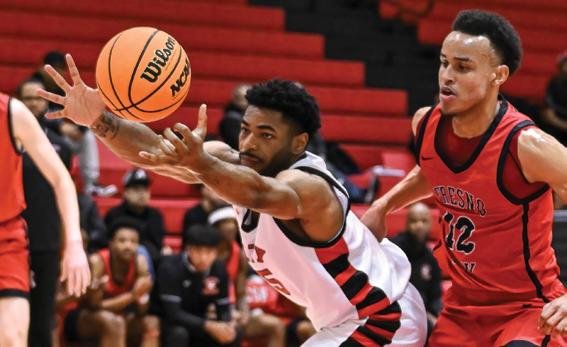
“It was a sluggish first half, and I take a lot of the blame for not leading my team.”
“We could've done way better. A lot of players didn't play well,” Cubley added.
Despite their early struggles, the Rams went into halftime with a commanding 37–24 lead, proving that their defensive adjustments and offensive efficiency were just getting started.
The second half became an entirely different story as the Rams emerged from their sluggish start and opened the half with an immediate full-court press, forcing Fresno into turnovers and poor shot selection.
The team continued its onslaught, pushing the pace in transition and capitalizing on fast-break opportunities. The chemistry between the team was undeniable, as they ran the floor like a well-oiled machine, punishing Fresno for every defensive lapse.
Adding to the offensive firepower, the Rams' bench provided key contributions. The depth of their roster became evident as fresh legs came in and continued the
relentless pressure. By the midpoint of the second half, the game had turned into a rout.
By the final buzzer, City College had extended their lead to a decisive 88–62 victory. The performance left little doubt about their potential this season. On the other hand, Fresno looked demoralized, as they simply couldn't keep up with the relentless pace and aggressive playstyle of the Rams.
Head Coach Justin Labagh looked critically at the players' performance: “They could've played better. They came into the game very nonchalant but stepped it up at half-time.”
This game was more than just a season opener for the Rams—it was a declaration. They proved that when they find their rhythm, they're a force to be reckoned with.
Their win against Fresno led them to the NorCal Regional Finals against the Jaguars, whom they defeated 80–70, thus advancing the Rams to the first round of the state championships, where they faced the San Antonio Cerritos on Thursday, March 13.

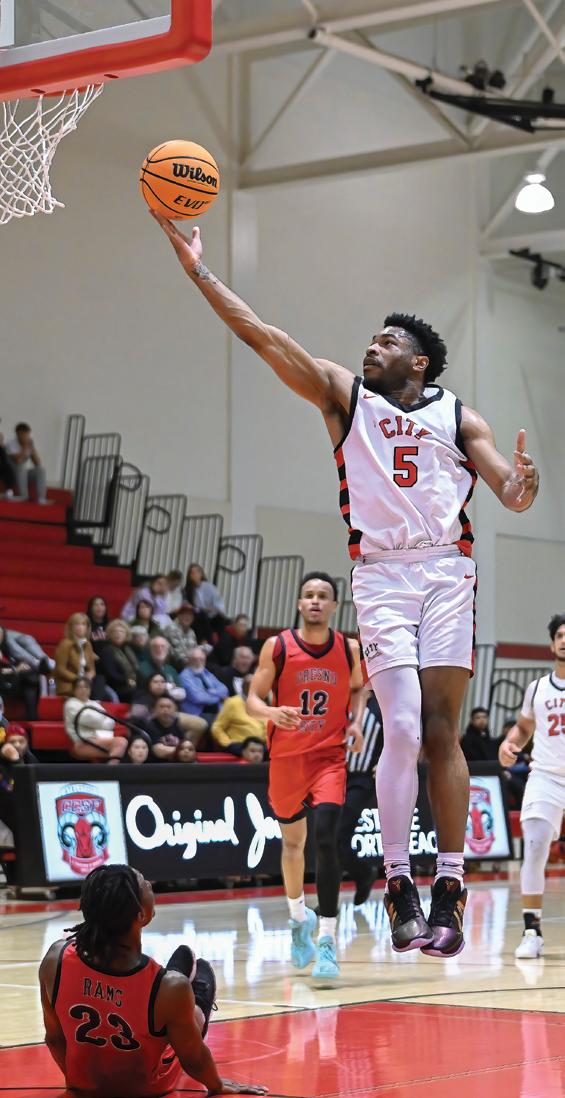
By Henry Crowell henrycrowell5@gmail.com
Gavilan College capitalized on City College's miscues and defeated the Rams 11–4 on Thursday, Feb. 27. Gavilan knocked eight hits throughout the innings, notably one less than the hometown Rams had with nine.
Dropping this game puts the City College record for the season at 4–9. They have yet to play a game against a conference opponent.
The Rams infield lost control, committing seven of the eight errors throughout the game.
“No excuses for this, we played horrible baseball,” said Coach Mendoza. “Like I told my team right now, we make eight errors, it's hard to win. You can't beat a little league team when you make eight errors.”
Freshman catcher Abraham Duran was a bright spot in the loss, knocking in two runs when he singled in the sixth inning, scoring himself in the 9th after taking a walk. Freshman third baseman Gary Ford had two hits with a run batted in.
Sophomore right fielder David Madera Jr. was also a contributor, slashing two hits and scoring a run.
Sophomore pitcher Muhammad Ahmad was viable in relief when he pitched three innings, striking out two players, walking three and surrendering no hits.
Gavilan's 4-run lead early in the first inning became a lead they would never relinquish.
Wear and tear could also be a factor, as City College had just returned from a road trip to Southern California, playing Antelope Valley College and Barstow Community College, some 365 and 418 miles, respectively, from Ocean Campus.
“It's good to be back home finally. Four games in three days, you learn a lot mentally and physically. It was a good learning experience for our guys, playing some good teams out there,” Coach Mendoza said.
“Just learning, we gotta play some better baseball,” Mendoza continued. “With conferences coming up, we have some good teams coming up, so we gotta start playing some good baseball.”

By Lloyd Cobb lcobb10@mail.ccsf.edu
The City College women's basketball team showcased its defensive prowess, securing a 58–43 victory over Shasta College in Saturday's second round of the Northern California Regional playoffs.
In the matchup against Shasta, the City College defense was dominant, holding Shasta to a 29% shooting average and forcing 25 turnovers. The Rams recorded 10 blocks and 16 steals, setting the tone early and maintaining pressure throughout the game.
Offensively, freshman guard Alessandra Nelson led the charge with 13 points, complemented by five rebounds, four blocks and two steals. Sophomore guard Madison Thomas contributed 11 points, three rebounds, three assists and three steals, while forward Stephania Salazar anchored the defense with nine rebounds and added 2 points.
Guard Jayden Borgna facilitated the offense with a team-high five assists alongside 3 points. Off the bench, forward Jacqueline Cox provided a perfect shooting performance, scoring 13 points on 5-out-of-5 shots, including a three-pointer, and adding 3 rebounds.
“I'm proud of our perimeter defense. It was a great collective team effort,” said Head Coach Derrick Lau, who praised his team's defensive efforts. This win propelled the Rams into the regional finals, extending their impressive winning streak to 12 games.
Following their win, City College went on to play the formidable San Joaquin Delta College in the regional finals in an away game. The Mustang's balanced attack and strong rebounding presented a significant challenge for the Rams, resulting in a devastating 86–56 loss, thus concluding the team's run for the state championship title.
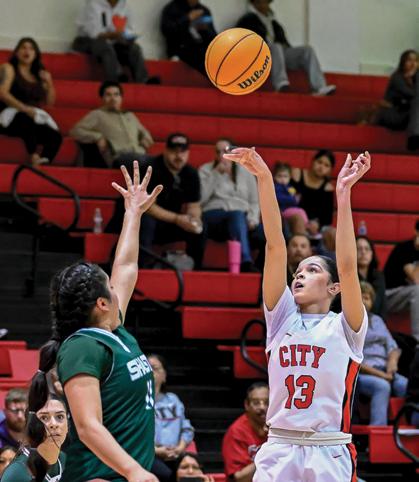

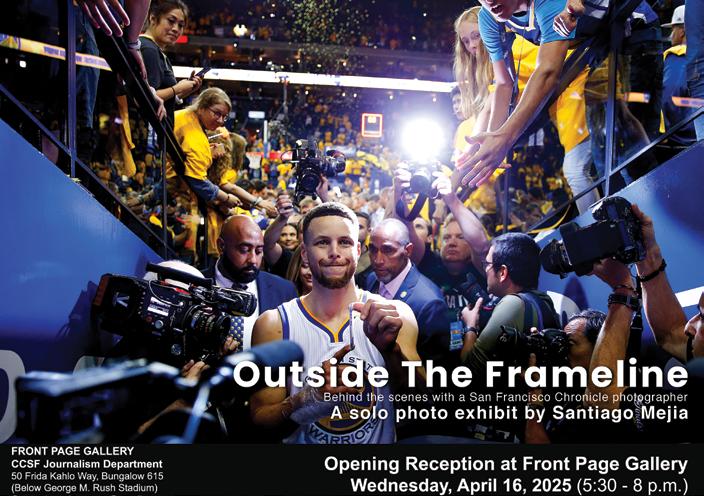

The Guardsman wants to hear what you think. Have something to say about the state of the world, or the state of City College? We welcome any and all community letters, however we reserve the right to not publish any submission. If you are a student please include your name and area of study. Please make all submissions to editor@theguardsman.com